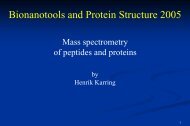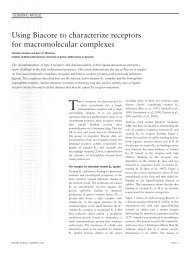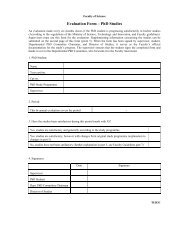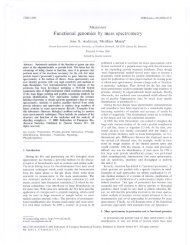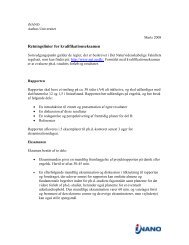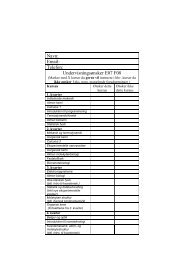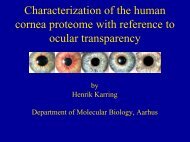Homogen catalysis
Homogen catalysis
Homogen catalysis
Create successful ePaper yourself
Turn your PDF publications into a flip-book with our unique Google optimized e-Paper software.
<strong>Homogen</strong> <strong>catalysis</strong><br />
1
<strong>Homogen</strong> <strong>catalysis</strong><br />
vs<br />
heterogeneous <strong>catalysis</strong><br />
2<br />
<strong>Homogen</strong>e <strong>catalysis</strong>:<br />
Production of compounds in multi-tons scale to gram scale –<br />
from simple to highly advanced compounds.<br />
Increased value ($/kg)<br />
Heterogenous <strong>catalysis</strong>:<br />
Production of compounds in multi-tons scale –<br />
mainly simple compounds<br />
Low value ($/kg)
<strong>Homogen</strong> <strong>catalysis</strong> vs<br />
heterogeneous <strong>catalysis</strong> –<br />
from a practical point of view<br />
3<br />
<strong>Homogen</strong>e <strong>catalysis</strong>:<br />
All constituents in one phase – liquid phase<br />
E.g. transition metal/organic catalyst – discrete catalyst<br />
Heterogenous <strong>catalysis</strong>:<br />
One or more of the constituents are in different phases<br />
Reaction takes place at the phase interface - the catalyst surface
Advantages - disadvantages<br />
<strong>Homogen</strong>e <strong>catalysis</strong>:<br />
Advantages: From small to large molecules<br />
One active site – control of selectivity<br />
Low catalyst loadings – high turnover<br />
4<br />
Disadvantages: Seperation<br />
Lower stability<br />
Sometimes – high catalyst loadings<br />
Complex mechanisms<br />
Heterogenous <strong>catalysis</strong>:<br />
Advantages: Seperation of reaction products from catalyst<br />
High stability<br />
Catalyst regeneration<br />
Low catalyst loadings – high turnover<br />
Disadvantages: Small molecules<br />
Several active sites - less control of side reactions<br />
”No” selectivity
Heterogeneous <strong>catalysis</strong> -<br />
small molecules with impact<br />
5<br />
N 2 + 3 H 2<br />
Catalyst<br />
2NH 3<br />
3-5% of the worlds<br />
energy production!
Small molecules with impact<br />
6<br />
H<br />
H<br />
H<br />
H<br />
+ O 2<br />
Ag110<br />
H<br />
H<br />
O<br />
H<br />
H<br />
H<br />
H<br />
O<br />
H<br />
H<br />
a large number of organic compounds<br />
- fundamental for the world<br />
H 3 C<br />
H 2<br />
C CH2<br />
CH 3<br />
V 2 O 5<br />
O<br />
O<br />
O<br />
14-electron oxidation!!!<br />
O<br />
O<br />
O<br />
+ O 2<br />
a large number of organic compounds<br />
- fundamental for the world
7<br />
Advantages for<br />
homogeneous <strong>catalysis</strong><br />
(a) Selectivity<br />
(b) Activity<br />
(c) Ease of modification<br />
(d) Easy of study<br />
(e) Efficiency
The physical chemistry behind <strong>catalysis</strong><br />
8
Activation of organic compounds<br />
by transition metals<br />
9<br />
Bonding ability - transition metal d-orbitals<br />
x<br />
z<br />
y<br />
d yz (d xy, d xz )<br />
d z 2 (d x 2 -y 2)<br />
Bonding ability - organic compounds<br />
LUMO - π*<br />
HOMO - π
Bonding interactions<br />
10<br />
HOMO<br />
LUMO<br />
LUMO<br />
HOMO<br />
M<br />
Cl<br />
Cl<br />
Pd<br />
Cl<br />
Electron-rich - HOMO(M)-LUMO(alkene)<br />
Wacker process<br />
Cl<br />
Cl<br />
Ti<br />
Cl<br />
Electron-poor - LUMO(M)-HOMO(alkene)<br />
Ziegler-Natta process
Wacker process<br />
11<br />
Cl<br />
Cl<br />
Pd<br />
Cl<br />
Electron-rich - HOMO(M)-LUMO(alkene)<br />
Wacker process<br />
H 2 O<br />
PdCl 2<br />
O<br />
Several millions tons/year<br />
Catalyst: [PdCl 2 ] n =<br />
Pd<br />
Cl<br />
Pd<br />
Cl<br />
Cl<br />
Cl<br />
Pd<br />
Cl<br />
Cl<br />
Pd<br />
Cl<br />
Cl<br />
Pd<br />
Commercially available<br />
insoluble oligomer<br />
rust brown
Looks simple – but no!<br />
12<br />
H 2 O<br />
O<br />
PdCl 2
R<br />
Ziegler-Natta<br />
TiCl 4 /<br />
AlCl 3<br />
R<br />
H 2<br />
C C<br />
H 2<br />
n<br />
Polymerization<br />
13
Reduction of alkenes<br />
14<br />
R<br />
H 2<br />
H<br />
R<br />
H<br />
L 3 RhCl
Asymmetric <strong>catalysis</strong><br />
15
Asymmetric <strong>catalysis</strong><br />
16
Pasteurs crystals<br />
17<br />
EtOOC<br />
OH<br />
HO<br />
COOEt<br />
EtOOC<br />
OH<br />
HO<br />
COOEt<br />
Chiral molecules
Chiral molecules<br />
18
Is the heart always to the left?<br />
19
Why are the stairs always turning the same<br />
way?<br />
20
21<br />
Carvone<br />
Mint<br />
Caraway
Chiral molecules - receptor interaction<br />
23
When it goes wrong<br />
24<br />
Goya: Mother showing her derformed child to two women<br />
Louvre, Paris
Nature gives us only one choice!<br />
26
Narwhale<br />
27
Chemical reaction<br />
31
Control of chirality with <strong>catalysis</strong><br />
32<br />
Energy<br />
Left<br />
Right<br />
E ‡ S<br />
E ‡cat R<br />
E ‡ R<br />
Reactants<br />
Product S<br />
Product R<br />
ee = (R-S)/(R+S)x100
Nobel prize – chemistry –<br />
2001<br />
33<br />
Dr. William S. Knowles, Monsanto Company, St. Louis, USA<br />
Professor Ryoji Noyori, Nagoya University, Japan<br />
”their work on chirally catalyzed hydrogenation reactions”<br />
Professor K. Barry Sharpless, The Scripps Research Institute, USA<br />
”his work on chirally catalyzed oxidation reactions”<br />
”This years Nobel Prize in Chemistry concerns the development of<br />
transition metal catalysts for stereoselective hydrogenation and oxidations –<br />
two important classes of synthetic reactions. Through the Laureates’ work<br />
a myriad of useful chiral compounds have become accessible”
34<br />
Catalytic asymmetric hydrogenation<br />
H<br />
H<br />
H H<br />
R<br />
R<br />
Kat.<br />
H H<br />
R<br />
H<br />
H
35<br />
Monsanto synthesis of L-DOPA - 1974<br />
MeO<br />
COOH<br />
H<br />
H<br />
MeO<br />
COOH<br />
AcO<br />
NHAc<br />
Rh-komplex<br />
AcO<br />
H NHAc<br />
100% udbytte<br />
95% ee<br />
OMe<br />
H 3 O<br />
P<br />
P<br />
HO<br />
COOH<br />
OMe<br />
HO<br />
H NHAc
Noyori hydrognation of alkenes<br />
36<br />
Ph Ph O<br />
P<br />
Ru<br />
P<br />
Ph Ph O<br />
O<br />
O<br />
(S)-BINAP-Ru-komplex<br />
CH 2<br />
MeO<br />
COOH<br />
H H<br />
Ru-komplex<br />
CH 3<br />
MeO<br />
(S)-Naproxen<br />
92% udbytte<br />
95% ee<br />
COOH<br />
H
38<br />
Warfarin<br />
- from rat poison to heart<br />
medicin<br />
OH<br />
O<br />
O<br />
O<br />
Warfarin
Warfarin<br />
39<br />
• One of the world’s most widely used anticoagulants<br />
• Prevents blood clotting and atrial fibrillation<br />
• Estimated 2 mill. users (USA) ~22 mill. presciptions/year (USA)<br />
• Sales ~500-1000 million $ a year (USA)<br />
• Different activity and metabolism of the enantiomers<br />
• Only marketed as a racemate for more than 40 years<br />
• Originally used as a rat poison<br />
OH<br />
O<br />
O<br />
O
Clinical pharmacology of warfarin<br />
40<br />
• 5-8 times higher anticoagulant activity of (S)-warfarin compared<br />
to (R)-warfarin<br />
• Half-lives of 21-43 h for (S)-warfarin and 37-89 h for (R)-warfarin<br />
• Different metabolic pathways of (S) and (R) enantiomers<br />
• Many problems with drug-drug interactions for racemic warfarin<br />
due to the metabolism of the (S)-enantiomer<br />
• A stable concentration is critical, but very difficult, to maintain<br />
OH<br />
O<br />
O<br />
O
41<br />
S-warfarin metabolized by cytochrome P450<br />
X-ray crystal structure of S-warfarin in cytochrome P450 2C9
Warfarin – clinical pharmacology<br />
42<br />
H<br />
N<br />
O<br />
H<br />
N<br />
O<br />
Glutamic acid residue<br />
in glycoprotein<br />
CO 2 H<br />
CO 2 H<br />
CO 2 H<br />
CO 2 γ-carboxy<br />
O glutamic acid<br />
2<br />
clotting factor<br />
OH<br />
OH<br />
Vit K - hydroquinone<br />
Me<br />
R<br />
O<br />
O<br />
Me<br />
O<br />
R<br />
Vit K - epoxide<br />
Vit K reductase<br />
O<br />
Me<br />
Vit K reductase<br />
Warfarin<br />
O<br />
R<br />
Vit K - quinone<br />
Warfarin
Asymmetrisk synthesis of<br />
warfarin<br />
43<br />
OH<br />
O<br />
O<br />
+<br />
Ph<br />
O<br />
Me<br />
Chiral catalysts<br />
OH Ph O<br />
O<br />
O<br />
Me<br />
Catalysts<br />
N<br />
H<br />
N<br />
Me<br />
CO 2 H<br />
H<br />
N<br />
N<br />
H<br />
(R) or(S)-warfarin<br />
>20 analogues<br />
CO 2 H<br />
Up to 85% yield<br />
70% ee<br />
Up to 96% yield<br />
82 % ee (99.9% ee after recrystallization)
How did it all start?<br />
45
46<br />
Questions - discussion<br />
• Discuss the origin of chirality<br />
• Discuss the activation of alkenes by early and late transition metal complexes<br />
• Try to understand the role of d-electron occupation<br />
• Discuss the reaction mechanism for Wacker process<br />
• Discuss the reaction mechanism for Ziegler-Natta procecss<br />
• Discuss the reaction mechanism for hydrogenation of alkenes<br />
• Calculate the increase in reaction rate by a reduction of the activation energy<br />
by 10 kcal/mol



